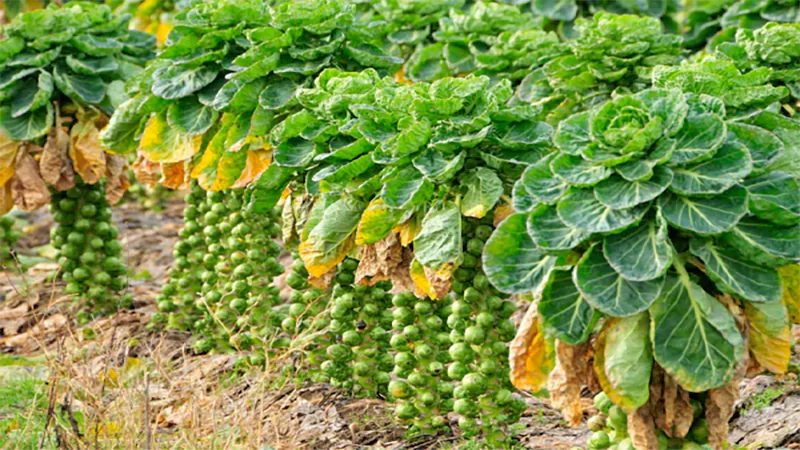Hollyhocks are tall and elegant flowering plants that can instantly enhance the charm of any garden space. These are classic cottage garden plants known for their height and vibrant blooms. Furthermore, hollyhock plants yield single or double blooms in striking hues such as pink, red, white, yellow, and occasionally almost black.
These bold blooms grow on tall spikes, making them perfect for back borders or against fences. Gardeners love Hollyhock flowers, not just for their visually appealing look, but also for their ability to attract pollinators.
Moving further, let us explore more about the botanical background of the genus, along with its popular varieties. Without any further ado, discover how Hollyhocks have become a timeless favorite among gardeners and plant lovers alike.
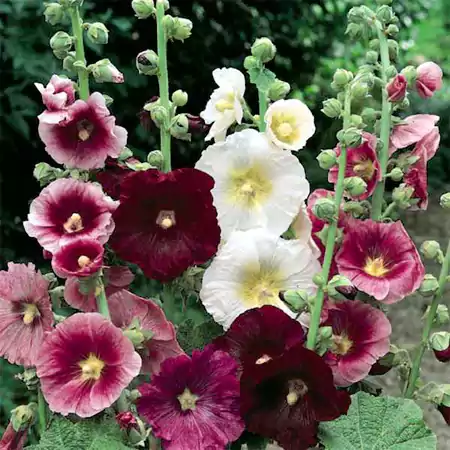
Introduction to Hollyhocks: Features and Benefits of the Flower
Hollyhocks are tall, colorful plants that stand out in any landscape. If you are looking for smart ways to elevate your home decor, adding these beauties to your front lawn or balcony garden can be an excellent option. Below is a list of their main features and benefits, they bring to home gardens and outdoor spaces.
- As mentioned earlier, Hollyhocks can grow up to 5–8 feet tall; therefore, they are perfect for adding height to garden borders or covering up walls and fences.
- These are adaptable to any garden style and are available in a wide range of bright and bold colors, including pink, red, yellow, white, and purple.
- Usually, the Hollyhock flower appears in late spring or early summer, adding color to the garden during the warmer months.
- Hollyhocks are a favorite among hummingbirds, butterflies, and bees, which contributes to the health and diversity of your garden.
- With minimal care and effort, these blooms thrive once they are provided with the basic growing conditions, such as sunlight and water.
- Looks great behind shorter flowers and adds balance to any garden setup. You can plant just a few or a full row, depending on your space and style, since these can easily fit small or large spaces.
These features and benefits make Hollyhocks a great pick for almost any garden. In short, these are colorful, easy to grow, and useful for beauty and garden health.
History and Symbolism of the Hollyhock Plant
Hollyhock flowers have a long history that goes back to ancient times. These blooms have been around for hundreds of years. They were first found in parts of Asia and the Middle East and were later brought to Europe.
People grew them not just for their beauty, but also for their healing uses in traditional medicines. The leaves and flowers were sometimes used for treating coughs and skin problems.
Additionally, Hollyhocks became popular during the Victorian era. They were often planted along the walls of cottages, where their tall flowers would grow against the stone and wood, mostly known to represent growth, prosperity, motherhood, and home life.
In Japan, Hollyhock seedlings hold special meaning. They are linked to protection and are celebrated during the Aoi Matsuri (Hollyhock festival) in Kyoto.
Even today, these blooms are said to symbolize strength, beauty, and simplicity, especially in pollinator gardens. Their ability to come back year after year makes them a symbol of quiet persistence.
Popular Varieties of the Holly Hock Flower
Hollyhock seeds come in many beautiful types, each with its own color, shape, and unique feature. Below are some popular cultivars of these exquisite blooms.
| Variety Name | Image | Description |
| Chater’s Double | 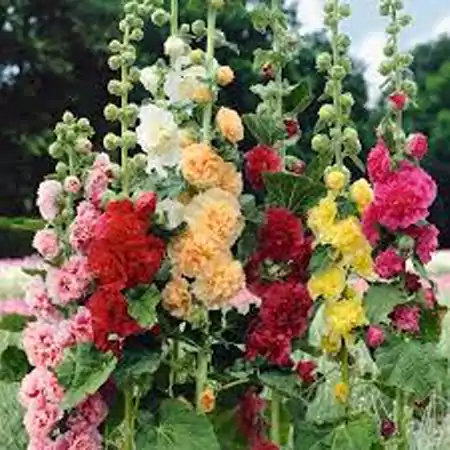 | Usually bears pink, red, yellow, and white flowers that are big and ruffled. Grows up to 5–7 feet tall. |
| Nigra | 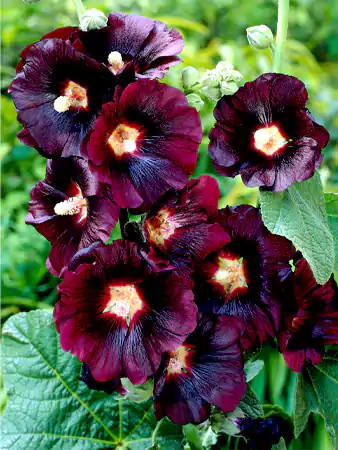 | Single blooms, mostly deep maroon (near black) in color. Rare historical variety, can grow up to 6-8 ft tall. |
| Peaches ‘n Dreams | 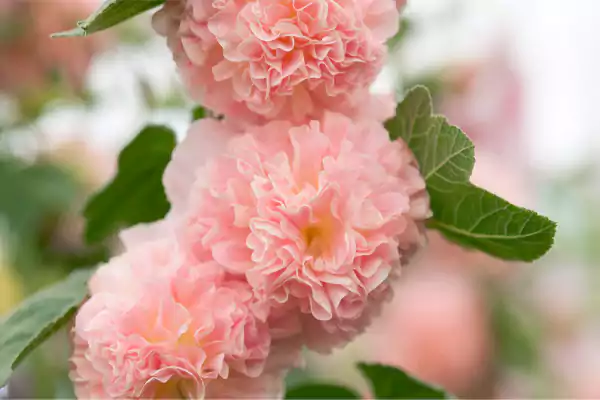 | The flowers are peach, pink, and white. Semi-double blooms, growing up to 5-6 ft tall. |
| Alcea ficifolia |  | Yellow, pink, and orange blossoms, usually rust-resistant, grow up to 4-6 ft tall. |
| Halo Series | 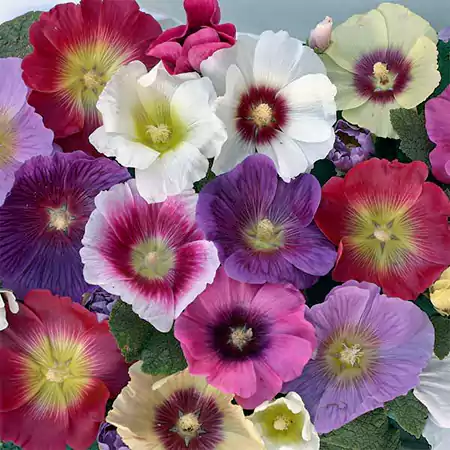 | Usually bears various eye-catching bi colored flowers with dark centers that grow up to 5-7 ft tall. |
Each of these Hollyhock seeds brings something different to your garden. Whether you are looking to add dark drama or soft pastels, there is a suitable Hollyhock variety for you.
How to Grow Hollyhocks from Seed to Bloom?
Do not worry if you are just starting with your gardening journey! Growing Hollyhocks from seed is easier than it seems. This section guides you step by step through the process to welcome those tall, colorful blooms in your garden. Let us explore how to plant Hollyhock seeds in detail.
- You can grow Hollyhocks by planting seeds either directly in the soil or starting them indoors. If you want to witness the blooms the same year, start sowing the seeds indoors 6–8 weeks before the last frost.
- Fill small pots with light, well-draining soil. Press the seeds about ¼ inch deep and water them gently. Make sure to keep the soil moist, not waterlogged. The seeds usually sprout in 10–14 days.
- Choose a spot that gets full sunlight and is protected from strong winds. Transplant the pots outdoors and place them 18–24 inches apart from each other to allow good airflow.
- Water them regularly, but don’t overdo it. Add mulch to keep the soil moist and prevent weeds. After blooming, allow a few flowers to turn into seed pods.
Once started, Hollyhocks mostly take care of themselves. But on the other hand, Hollyhocks are susceptible to rust, so be mindful of leaf removal and disposal to minimize disease spread.
Best Growing Conditions for the Genus
To grow healthy hollyhocks, you need to give them the right nourishment. They are easy to care for if you simply meet their basic needs. Let us understand the optimal growing conditions required for these tall-growing plants.
- Sunlight: Hollyhocks demand full sun, at least 6 hours of direct sunlight daily. Less exposure can lead to weak stems and fewer flowers.
- Soil Type: Use well-draining soil, preferably loamy or sandy. Enrich the soil with compost and aged manure before planting. Ideal pH is between 6.5 and 7.5 (slightly alkaline to neutral).
- Watering: Water regularly during dry periods, but do not overwater. Avoid wetting the leaves to prevent fungal infections. Water the base of the plants to keep the roots healthy.
- Support and Mulching: Use stakes or garden support for tall varieties, especially in windy spots. Add mulch to keep the soil moist and top weeds from growing.
Be sure to sow Hollyhock seedlings 18–24 inches apart to give them space to grow. Good airflow between plants helps prevent diseases like rust. With the right sunlight, soil, and care, hollyhocks grow strong and tall.
Common Pests and Diseases and How to Fix Them
Even healthy Hollyhock leaves can face problems like pests and plant diseases. Here is a simple guide to the most common issues and how you can treat or prevent them easily.
| Problem | How to Spot Them | Fix or Prevention |
| Rust (fungus) | Orange or brown spots on leaves, especially lower ones. | Remove infected leaves, avoid wetting them, and use neem oil. |
| Aphids | Tiny green/black bugs on buds, sticky larvae-like residue. | Spray with neem oil or soapy water; ladybugs also help in getting rid of these. |
| Japanese Beetles | Chewed leaves and flower petals. | Handpick them early in the morning, and use beetle traps. |
| Slugs and Snails | Holes in lower leaves, especially in moist areas. | Use slug pellets or copper tape around the plant base. |
| Spider Mites | Fine webbing under leaves, yellow spots on the petals. | Spray with a water jet, use insecticidal soap, or neem oil. |
Most Holly Hocks grow well if they have proper sunlight and airflow. Overcrowding and overwatering are the main causes of problems. Regular checks can help prevent all of these issues. Also, be sure to clean up fallen leaves at the end of the season to stop disease from spreading next year.
Are Hollyhocks Perennial? Do They Come Back Every Year?
Many people wonder if Hollyhocks bloom year after year. This section explains whether these species are annual, biennial, or perennial, and what to expect after your first season of growth.
Most plants are biennials, which means they grow leaves in the first year and bloom in the second year, and then die. However, a lot of perennial varieties reappear after two to three years or longer.
The positive aspect of this plant is that it often grows by self-seeding. New plants grow naturally the next season, making it look like the same plant is returning every year. While not all hollyhocks are considered perennial, they can still behave like perennials with proper management.
Final Thoughts
As has been repeatedly said, Hollyhocks are more than just tall flowers in the background; they carry a history of their own, are a pollinator’s dream, and a joy for home gardeners. With their beauty and cultural significance, they quietly brighten corners and fences, while enhancing the overall look of the landscape.
What amazes me the most is their ability to attract bees and butterflies. Additionally, with just minimal care and providing the genus with basic growing conditions, these can be rewarding and functional. Without any further ado, get your hands soiled and start planting Hollyhock seeds!
Do Hollyhocks come back every year?
The regrowth of this plant depends entirely on the type of species it is. Most of them are biennials, but there are some perennial cultivars too.
Why are Hollyhocks hard to grow?
The only hard part about growing these beautiful, tall flowers is that they are prone to fungal diseases like rust and aphids. They need full sun exposure and good airflow to flourish.
What are the cons of Hollyhocks?
One of the major cons of Hollyhocks is their susceptibility to pests and diseases. The flowers of some cultivars last only a few days, and once they complete their lifecycle, the garden area needs extensive cleaning.
Are Hollyhocks poisonous to dogs?
No, this genus is not poisonous to dogs, although eating in large amounts may cause mild stomach ache and diarrhea.
Do Hollyhocks like sun or shade?
Hollyhocks prefer growing in bright, direct sunlight.
Alcea rosea – NC State Extension

